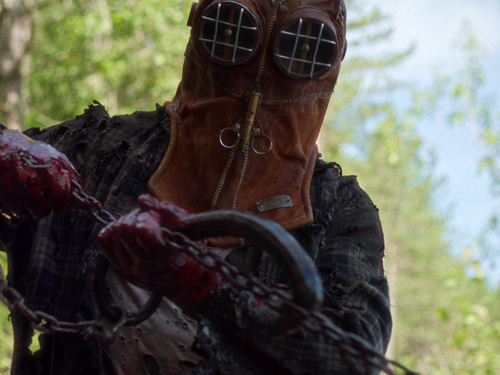
While watching any of the 10 Friday the 13th sequels, have you ever wondered how Jason Voorhees conveniently winds up at exactly the right place to impale a promiscuous camper? Chris Nash’s deconstructionist slasher, In a Violent Nature, provides an undeniably poignant answer: He just walks.
Well, he walks after a random camper nabs a necklace that kept the monster buried beneath a charred sawmill. The plot is intentionally bare bones: The killer wanders into town, then finds an iconic mask and weapon before brutally dismembering folks with blood-chilling creativity.
The film rebukes most of the genre’s typical quick cuts and relentless jump scares. Instead, it favors a slow, methodical and over-the-shoulder approach that follows a reanimated serial killer as he slaughters foul-mouthed farmers, angsty campers and a lawman with a narratively convenient legacy. It’d be easy to compare the shifted focus to Scott Glosserman’s Behind the Mask: The Rise of Leslie Vernon, though even that mockumentary falls headfirst into the conventions it tries to critique.

That’s not to suggest In a Violent Nature doesn’t lean on tropes, but it at least juggles and harnesses them in a unique and mostly satisfying way. Its contemplative pace and unflinching cinematography don’t beg questions, but evoke a feeling like David and Nathan Zellner’s Sasquatch Sunset. The film only wanes when it gives into slasher norms — specifically breaking away from the killer’s perspective — in what is presumably an attempt to break up the monotony. And though the frequent, slower sequences sometimes border meandering, they also allow the film’s bloated zombie to float above a swamp of nameless, uninspired killers.
In dissecting slashers, however, the flick also must lean into them. This means campy dialogue runs rampant. At times, it works to cast historically poor lighting in a different light, sort of like the ineffable chirps of some finches before they’re snagged by a bird-eating spider. A particularly egregious campfire scene almost squanders this effect, as the film spends a bit too long removed from its subject for the sake of dumping some ultimately unnecessary exposition. It’s as though Nash didn’t trust his premise, fearing it would veer into Skinamarink territory and bore the audience. While he might be right, leaning into the gory nature doc vibe a bit more could’ve help the film garner a little more permeance.
Some small stumbles aside, In a Violent Nature still manages to carve a path that should intrigue even those less inclined to slashers. Its clinical approach to kills paired with a genuinely haunting ending makes it a clear frontrunner (or maybe “frontwalker”) for the best horror film of 2024. —Daniel Bokemper

